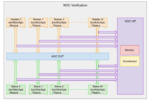While Truechip has established itself as a global provider of verification IP (VIP) solutions, they are always on the lookout for strategic IP needs from their customer base. Over the last several years, a solid market for Network-on-Chip (NoC) IP has grown, driven by the need to rapidly move data across a chip. Concurrently, the… Read More
Author: Kalar Rajendiran
Elevating Production Testing with proteanTecs and Advantest’s ACS Edge™ Platforms
SemiWiki recently posted a blog on “Deep Data Analytics for Accelerating SoC Product Development.” That blog focused on proteanTecs’ AI-enabled chip analytics platform that helps accelerate SoC product development. The blog provided insight into proteanTecs’ approach and shared quantifiable business-impact metrics … Read More
Quadric’s Chimera GPNPU IP Blends NPU and DSP to Create a New Category of Hybrid SoC Processor
Performance, Power and Area (PPA) are the commonly touted metrics in the semiconductor industry placing PPA among the most widely used acronyms relating to chip development. And rightly so as these three metrics greatly impact all electronic products that are developed. The degree of impact depends of course on the specific … Read More
New Cadence Joint Enterprise Data and AI Platform Dramatically Accelerates AI-Driven Chip Design Development
Without data, there is no computing field to talk about, no technology world to awe at and not much of a semiconductor industry to work in. There is no argument that data is the foundational piece for everything, has been to date and will continue to be. While processing an application’s input data is essential to serve the intended… Read More
NIST Standardizes PQShield Algorithms for International Post-Quantum Cryptography
News of cyberattacks is routine these days in spite of the security mechanisms built into widely used electronics systems. It is not surprising that entities involved with ensuring safe and secure systems are continually working on enhancing encryption/decryptions mechanisms. Recently NIST standardized cryptography algorithms… Read More
CEVA’s LE Audio/Auracast Solution
CEVA announced that its RivieraWaves Bluetooth® 5.3 IP family now supports Auracast™ broadcast audio. The technology behind Auracast is LE Audio broadcasting and Auracast is expected to transform the shared audio experience. With Auracast, an audio stream is broadcast over the air by means of Bluetooth Broadcast Isochronous… Read More
VeriSilicon’s AI-ISP Breaks the Limits of Traditional Computer Vision Technologies
The tremendous growth in edge devices has focused the spotlight on Edge-AI processing for low latency, low power and low-DDR bandwidth compute needs. Many of these Edge-AI applications depend on effective and efficient processing of image and video streams which in turn relies on computer vision technology. In early September,… Read More
Measuring Success in Semiconductor Design Optimization: What Metrics Matter?
When it comes to electronic design automation (EDA), there are two aspects to this technologically challenging and highly competitive field. First, there is the task of designing very complex chips for which a full suite of various software tools are needed. Then there is the task of managing extremely complex EDA workflows and… Read More
How Deep Data Analytics Accelerates SoC Product Development
Ever since the birth of the semiconductor industry, advances have always been at a fast pace. The complexity of SoCs have grown along the way, driven by the demanding computational and communication needs of various market applications. Over the last decade, the growth in complexity has accelerated at unforeseen rates, fueled… Read More
CEVA Accelerates 5G Infrastructure Rollout with Industry’s First Baseband Platform IP for 5G RAN ASICs
The 5G technology market is huge with incredible growth opportunities for various players within the ecosystem. As a leading cellular IP provider, CEVA has been staying on top of the opportunity by offering solutions that enable customers to bring differentiated products to the marketplace. Earlier this year, SemiWiki posted… Read More




















Quantum Computing Technologies and Challenges